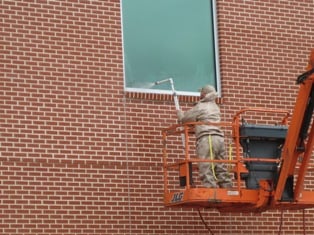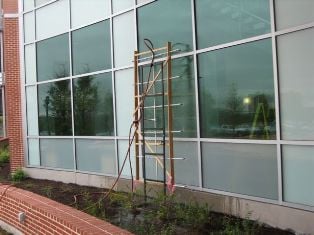Benefits of Independent Third Party Waterproofing Inspections

- By Jay F. Webster
- Building Envelope Consultant
- Raba-Kistner Consultants, Inc.
It costs less to build a structure once. It costs less to fix mistakes while the building is still under construction and even less to design it right while still on paper. Independent third party inspections can benefit the owner, architect, general contractor and the installer or subcontractor and help reduce construction call backs due to water infiltration from the roof and windows.
No one intentionally installs windows backward, but it happens. On some large buildings, complexes and campuses, the labor force can outnumber the project supervision by 10 times. With new products being installed and multiple trades working on the same wall or window opening, some strange things can happen. Regardless of whether it is the roof, below-grade waterproofing, walls or windows, any one of these installations done incorrectly can be costly to repair and damage professional credibility. And no one wants to sit across the table from an unhappy owner and their attorney.
Successful waterproofing installations are the result of solid design, quality products and proper installation, but an on-site construction inspector can lend an additional bit of insurance. Using a team approach can make it easier to get the long-term performance expected from any waterproofing system, and third party inspection can help provide the following:
- Design Assistance - System design and specification guidance regarding the type of waterproofing system that is best suited to the project’s site conditions and construction type.
- System Review - The manufacturer’s and consultant’s technical staff can provide a thorough review of the specifications and details for constructability and completeness. This is referred to as a “peer review.”
- Complete Product Offering - Some manufacturers can offer a variety of products and systems including membranes, waterstops, drainage products and detailing accessories with assurance of compatibility.
- Job-Specific CAD Details - Job and product specific CAD generated details minimize field decisions and confusion which are always schedule and cost motivated.
- Quality Assurance - Includes a mandatory pre-construction meeting, site photos, installation observation and reports for review of installation with all involved parties.
- Material Installation by Experienced, Approved Applicators - Assures proper material installation within manufacturer’s guidelines by professionally trained applicators and secures manufacturer’s warranty.
- Independent Inspection - Verifies proper installation and ensures materials are not damaged prior to coverage of work.
- Contractual Accountability - A manufacturer’s warranty should provide a direct contract between the building owner and waterproofing manufacturer.
- Financial Assurance - A reliable material and labor waterproofing warranty provided by the manufacturer.
- Owner’s Insurance - With the use of certain procedures it may be possible to obtain lower insurance rates for the use of better products, third party observation and testing.
- Contractor’s Bonding - With fewer call backs and problems, the general contractor will see an increase in bond rating and amount as well as an overall increase in profits.
Owners
Independent third party inspections benefit owners in many ways. In addition to getting a finished product where materials are designed and installed correctly, the building will provide excellent service and have fewer problems with moisture and air intrusion. The greatest impact will be realized with lower operating costs on higher performing buildings. This translates right to the bottom line on building efficiency and a faster return on investment.

Architects and Engineers
The design community can use a peer review and third party inspection as a way of ensuring the constructability of the drawings and that the design intent is carried out in the field. This contributes to risk management and reduces the exposure to construction errors. It’s a lot easier to address a question when the design is still on paper than when it is already built. The architect and engineer’s liability insurance may also decrease if these are standard practices endorsed by their insurance carrier.
General Contractors
General contractors can be well served by independent third party inspections. Fewer call backs mean more of the profit is kept as profit rather than spent on service calls, or worse yet, attorney’s fees. In addition, third party inspections are a good check on how the construction crew is doing. A contractor’s reputation is best maintained with a good quality product delivery.
Because leaks are most often the result of improper material installation, the best solution is to have a trained and experienced applicator install a properly designed waterproofing system. Using an approved applicator provides these advantages:
- Ensures installation quality for maximum performance.
- Minimizes risk of moisture damage and long-term repair costs.
- Experienced professionals who are knowledgeable about waterproofing applications install the materials with efficiency and in a timely manner.
- More and more construction product manufacturers require applicators to be factory and field certified before they will offer warranties on products and installations. The cost to come back a year after the building has been completed can be twice as much as the original contract for the services.
When it comes to the waterproofing on a building, problems are difficult and expensive to resolve. The materials are usually difficult to access, being mostly installed within the wall or roof cavities. In a large number of cases repair costs can quickly escalate to many times the cost of the initial installation. Most leaks occur not because the materials were defective but because of these primary causes:

- Improperly designed and/or installed waterproofing systems.
- Poorly prepared substrates.
- Damage after installation by subsequent construction traffic and operations.
- Solutions to specific job site needs which can lead to incomplete or faulty installations to keep the project on schedule and the initial expense down.
Working with an independent inspection firm can help eliminate these issues and offers an additional layer of assurance to the project by providing the following services:
- Pre-construction meetings
- Design review
- Observats, inspections and reporting
- Recommendations
- Testing systems
Ultimately, team work has always been the best formula for the successful construction of a building. Adding independent third party inspections to the team can be the element that ensures the building envelope components are correctly designed and installed to create a more air and water tight building.
Mr. Webster joined Raba-Kistner Consultants, Inc. in June 2008. Mr. Webster’s primary focus is the investigation of air and water infiltration into the building envelope. In addition to on-site observations and testing, Mr. Webster is involved in the design of below-grade waterproofing systems and performing peer review of construction documents and specifications. He can be reached at 210-699-9090 or jwebster@rkci.com.
Subscribe Today!
Stay-in-the-know and subscribe to our blog today!